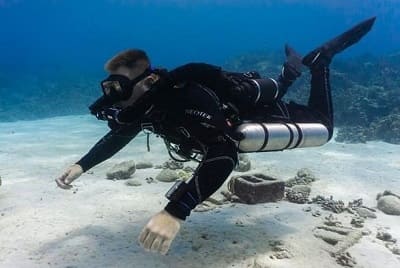Home › A-Z Diving › Equipment › Sidemounts
Side Mount Scuba Diving
There are several reasons why some divers prefer to dive with a cylinder configured along each side of their body, instead of mounting it on their back.
This guide explains the basics about sidemounts, such as why some divers say sidemount diving is better, and how the setup differs to a traditional scuba cylinder and BCD.
What is Sidemount Configuration in Diving?
This type of setup is popular with divers who go inside caves, penetrate wrecks, and in technical diving.
The benefits of scuba diving with a side mounted configuration include:
- Accessibility
- Comfort
- Flexibility
- Low profile
- Safety
Put another way, divers who swim in water with this kind of layout say it reduces drag and it's more comfortable to wear.
Some divers find it challenging to lift heavy scuba cylinders and walk around while wearing a regular backmounted setup.
Thus, some sidemount divers will enter the water without any dive tanks at all, and then they will attach two small cylinders at the surface.
Pro Tip: It's common for technical divers to carry several extra cylinders. Most of them will do so using some kind of sidemount setup.
PADI Sidemount Diving Course
There are several PADI® sidemount diver courses with different techniques and restrictions. But, the most popular are:
- Sidemount Rec Diver (recreational)
- Tec Sidemount Diver (technical: mounting a minimum of four tanks)
Key Features of Sidemounts
In most cases, you will use a wing BCD to attach the sidemount tanks. The harness offers a better choice of strong tank attachment points than traditional backmounted BCDs.
 Attachment points are located at the hip, on the upper torso, and armpit level (on both sides).
Attachment points are located at the hip, on the upper torso, and armpit level (on both sides).- Configurations tend to use some kind of bungee elastic system (tubing) to secure the tanks in place. Others will involve clip assemblies attached to chest D-rings.
- There will be at least one regulator equipped with the submersible pressure gauge (SPG) and a low pressure inflator hose hooking into the BCD.
Alternatives and Extras
Most harnesses have extra padding, crotch straps, and pockets for carrying solid lead weights. Hence, they will be more comfortable and you should find it easier to balance your trim.
Moreover, some of the modern harnesses allow for interchanging parts with a BCD. So, you could use the system for diving with a backmount or a sidemount.
Here's the thing:
Depending on the system you use, you can also fine-tune your weight position during the actual dive by moving the cylinder-mounted weights (e.g. further up or lower down the tank).
Pro Tip: Some kinds of buoyancy controllers used in cave diving have hose attachments nearer to the bottom of the bladder, instead of being located at the top.
Choosing a Sidemount Diving Rig
It's best to get some advice from a Sidemount Instructor before purchasing a system. But, some of the important considerations will be:
- Where will you be diving and how accessible is it going to be? Plus, different tanks determine how much lift is needed from the BCD.
- Handling the clips and attachments will be more difficult if you will be wearing thick dive gloves. So, choose a rig that you find easy to add and remove tanks with gloves on.
- Will you be able to secure and release tanks in choppy seas or on a moving platform (e.g. boat diving with a sidemount system).
Maintenance
It will be important to keep your sidemount equipment in good working order. Some of the general maintenance procedures for sidemounts include:
- Rinsing the rig thoroughly with fresh water after each use and remembering to clean the Buoyancy Control Device (BCD) on the outside and inside.
- Letting the system dry out completely (away from direct sunlight if possible).
- Emptying the weights from the harness pockets and then partially inflating the BCD before storing it in a cool dry place.
Pro Tip: You can learn more about making basic adjustments, providing general care for scuba gear, and carrying out regular cleaning and maintenance tasks in the PADI Equipment Specialist course.